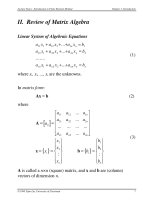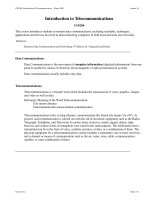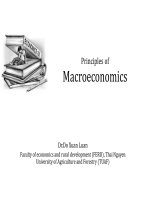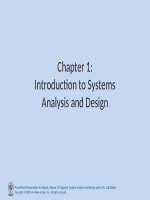Lecture Business economics - Lecture 1: Introduction to Business
Bạn đang xem bản rút gọn của tài liệu. Xem và tải ngay bản đầy đủ của tài liệu tại đây (172.92 KB, 18 trang )
Lecture 1
Introduction to Business
economics - I
Instructor: Prof.Dr.Qaisar Abbas
Course code: ECO 400
Introduction
Course instructor: Prof. Dr.Qaisar Abbas
Course title: Business economics
Credit hours: 3 (3,0)
Course code: ECO400
Course Objective
• Understanding of micro and macroeconomics concepts
•
Business applications of economics
Introduction
Course Outline
1. Introduction to Business economics
2. Market forces of supply and demand
3. Elasticity
4. The theory of consumer choice
5. The Costs of Production
6. Firms in Competitive Markets
7. Monopoly
8. Monopolistic Competition
Introduction
9. Measuring a Nation’s Income
10.Production and Growth
11.Saving investment and financial system
12.Unemployment
13.Unemployment and Inflation
14.Money and Inflation
15.Open economy
16.Aggregate demand and aggregate supply
17.Poverty
18.Economy of Pakistan
Introduction
Core texts
•
Principles of economics, N. Gregory Mankiw
Additional reading
•
Managerial economics and business strategy,
Michael.R.Baye
Assessment Method
•
4 Quizzes
10%
•
4 Assignment
15%
•
1st sessional
10%
•
2nd sessional
15%
•
Final Exam
50%
Lecture Outline
1. Introduction to Economics/ definitions
2. Ten principles of economics
3. Why Manager needs to Study economics
Introduction
Evolution of Economics
•
In old days people used the word “ oikonomos” for the management
of house affairs.
•
Development of civilization extended oikonomos to frontiers of the
country and resulted it in becoming “political economy”, which dealt
with various economic affairs of the country.
•
1770 industrial revolution gave rise to problems like housing,
transport, unemployment which extended political economy to
“economics”.
Definitions of economics
The definition of economics evolved through three stages.
1. Definition of the Classical school of thought led by Adam Smith
2. Definition of the Neo Classical school of thought led by Alfred
Marshall
3. Definition of the Modern school of thought led by Lionel Robbins
Introduction
1. Definition of the Classical school of thought led by
Adam Smith
•
In 1776 Adam Smith defined economics as a Science of Wealth.
•
He discussed wealth from four different aspects
i.
Production of wealth: Goods and services produced with a
combination of land, labor, capital and organization.
ii.
Exchange of wealth: Enables society to satisfy multiple wants.
iii. Distribution of wealth: Everybody gets everything produced in the
country
iv. Consumption of wealth: Utility of goods and service for satisfaction.
Criticism
•
It could make society materialistic
Introduction
2. Definition of the Neo Classical school of thought led by
Alfred Marshall
Dr. Alfred Marshall’s in 1798 defined economics as
“Economics is a science which studies human behavior in the
ordinary business of life; it examines that part of individual and
social action which is most closely connected with the attainment
and with the use of material requisites of well being.”
Criticism
•
It limits the scope of economics as it leaves out non material
requisites of well being.
•
Material requisites which do not promote welfare are excluded e.g.
drugs, cigarettes etc.
•
Welfare is not a measurable concept.
•
Problems in policy making as it creates a problem of liking and
disliking.
Introduction
3. Definition of the Modern school of thought led by Lionel
Robbins
Robbins's Defined economics as
“Economics is a science which studies human behavior as a
relationship between multiple ends and scarce means which have
alternative uses.”
Merits
i.
Comprehensive
ii.
Extension of economics scope to services
iii. Analytical in nature which helps in problem resolving.
Demerits
i.
He tried to make economics as pure science whereas its is a social
science.
ii.
There is no touch of morality.
iii. He says resources are limited and does not explain the increase in
limited resources.
Introduction
A household and an economy face many decisions:
•
•
•
•
Who will work?
What goods and how many of them should be produced?
What resources should be used in production?
At what price should the goods be sold?
Society and Scarce Resources:
•
•
The management of society’s resources is important because
resources are scarce.
Scarcity. . . means that society has limited resources and
therefore cannot produce all the goods and services people
wish to have.
Economics is the study of how society manages its scarce
resources.
Types of economics
Microeconomics focuses on the individual parts of the economy.
How households and firms make decisions and how they interact in
specific markets
Macroeconomics looks at the economy as a whole.
Economy-wide phenomena, including inflation, unemployment, and
economic growth
Ten principles of economics
How people make decisions.
•
•
•
•
People face tradeoffs.
The cost of something is what you give up to get it.
Rational people think at the margin.
People respond to incentives.
How people interact with each other.
•
•
•
Trade can make everyone better off.
Markets are usually a good way to organize economic activity.
Governments can sometimes improve economic outcomes.
The forces and trends that affect how the economy as a
whole works.
•
•
•
The standard of living depends on a country’s production.
Prices rise when the government prints too much money.
Society faces a short-run tradeoff between inflation and
unemployment.
Ten principles of economics
Principle #1: People Face Tradeoffs.
•To get one thing, we usually have to give up another thing.
Guns v. butter
Food v. clothing
Leisure time v. work
Efficiency v. equity
•
Making decisions requires trading off one goal against another.
Efficiency v. Equity
• Efficiency means society gets the most that it can from its
scarce resources.
•
Equity means the benefits of those resources are distributed
fairly among the members of society
Ten principles of economics
Principle #2: The Cost of Something Is What You Give Up to
Get It.
•
Decisions require comparing costs and benefits of alternatives.
1. Whether to go to college or to work?
2. Whether to study or go out for shopping?
3. Whether to go to class or sleep in?
•
The opportunity cost of an item is what you give up to obtain that
item.
Principle #3: Rational People Think at the Margin.
•
•
Marginal changes are small, incremental adjustments to an existing
plan of action.
People make decisions by comparing costs and benefits at the
margin.
Ten principles of economics
Principle #4: People Respond to Incentives.
•Marginal changes in costs or benefits motivate people to respond.
•The decision to choose one alternative over another occurs when that
alternative’s marginal benefits exceed its marginal costs!
Principle #5: Trade Can Make Everyone Better Off.
•People gain from their ability to trade with one another.
•Competition results in gains from trading.
•Trade allows people to specialize in what they do best.
Principle #6: Markets Are Usually a Good Way to Organize
Economic Activity.
•A market economy is an economy that allocates resources through the
decentralized decisions of many firms and households as they interact
in markets for goods and services.
• Households decide what to buy and who to work for.
• Firms decide who to hire and what to produce
Ten principles of economics
Principle #7: Governments Can Sometimes Improve Market
Outcomes.
•
•
•
Market failure occurs when the market fails to allocate resources
efficiently.
When the market fails (breaks down) government can intervene to
promote efficiency and equity.
Market failure may be caused by
1. an externality, which is the impact of one person or firm’s
actions on the well-being of a bystander.
2. market power, which is the ability of a single person or firm to
unduly influence market prices.
Principle #8: The Standard of Living Depends on a
Country’s Production.
Standard of living may be measured in different ways:
1. By comparing personal incomes.
2. By comparing the total market value of a nation’s production.
•
Almost all variations in living standards are explained by
differences in countries’ productivities.
Ten principles of economics
•Productivity is the amount of goods and services produced from each
hour of a worker’s time.
Principle #9: Prices Rise When the Government Prints Too
Much Money.
•Inflation is an increase in the overall level of prices in the economy.
•One cause of inflation is the growth in the quantity of money.
•When the government creates large quantities of money, the value of
the money falls.
Principle #10: Society Faces a Short-run Tradeoff Between
Inflation and Unemployment.
•The Phillips Curve illustrates the tradeoff between inflation and
unemployment:
•It’s a short-run tradeoff!
Why managers need to study
economics?
1. Informed and rational decision making
2. Better policy making
3. Enhancement of analytical skills
4. Not limited to profit-making firms and
organizations
5. Optimum utilization of scarce resources









